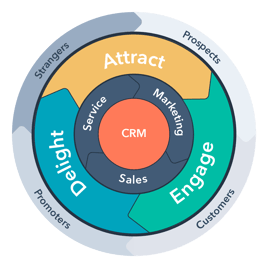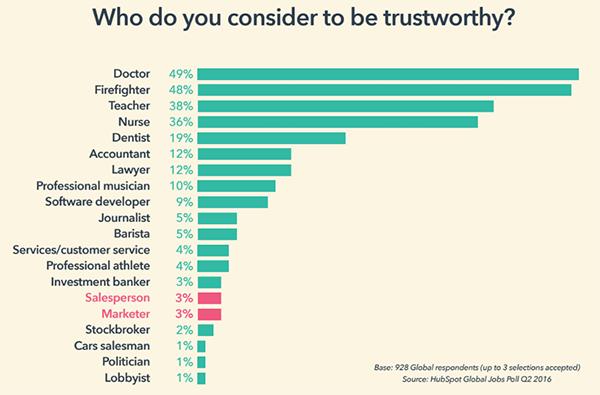The HubSpot Inbound Conference 2018, considered by many as the Mecca of Marketing, has come and gone. It keeps getting larger and larger every year and last year it saw over 20 000 participants come from all corners of the world swoop down on Boston to attend, connect and learn.
The theme this year was “Grow Better” and all the talks and breakouts were focused on how not to only grow your business bigger but how to grow it better!Although we were not there this year (next year will be a different story), we have scoured every corner of the Internet, watched countless YouTube videos and gone through numerous social media feeds to find the best highlights and lessons that you can apply to your marketing efforts for 2019 and beyond.
So without further ado, we present to you the 10 things that we have learned from Inbound 2018:
1. HubSpot's new philosophy - Moving from the marketing funnel to the flywheel
 As the market moves more and more towards being customer-centric there are certain cracks that have begun to show in the traditional inbound marketing funnel that marketers have been using for years
As the market moves more and more towards being customer-centric there are certain cracks that have begun to show in the traditional inbound marketing funnel that marketers have been using for years
The biggest crack that’s evident, is that the funnel concentrates on moving a total stranger through a series of conversion steps until they buy.
Then the process starts again by shifting efforts to another stranger and attempting to move them through the funnel until they too hopefully become a customer.
Essentially, the funnel prioritises making the sale rather than providing an overall great customer experience.
Customer acquisition costs have become so high that companies can no longer afford to ignore existing customers, they have to realise that these customers can become one of their biggest assets.
The flywheel puts focus on the customer by putting them at the centre of the company’s marketing efforts and uses the customer as an input for future customer acquisition.
2. Your best lead generation source is happy customers
Content marketing is a powerful tool to attract strangers, turn them into leads and eventually customers. But in the last 10 years, the channels that once worked like blogs, emails and social media posting, have become crowded.
The amount of information that customers are exposed to has become so much that they are now filtering it out.
They are no longer reading every single blog post, and email open rates have dropped. Marketers have reached a point where they are fighting for the customer's attention.
The overload of information means people are turning to their friends or reading through customer reviews as a source of trustworthy and reliable information to help them make their purchasing decisions.
Trust for marketers is at an all-time low, with people trusting lawyers more than they do marketers.
What customers are saying about our businesses, our products and the overall experience that they had dealing with us has never carried more weight than right now. It is, therefore, crucial that we make sure that our customers are delighted at every interaction they have with us.
In 2019, marketers need to move away from the mentality that their job is done once they close the lead.
Nowadays the additional work of delighting the customer and turning them into a promoter of the company is just as vital.
3. SEO is changing
Google Search is becoming smarter with every iteration and it is becoming increasingly difficult to game the search algorithm. This requires us to also change the way that we do SEO.
Google makes between 500-600 algorithm updates per year, so what was working last year may no longer be effective this year and to add to that, the real estate on page 1 of a Google search engine results page has become hotly contested.
Where we traditionally used to see a paid advert and 10 blue links, we now have to take into consideration that there are several kinds of Google search results such as featured snippets, knowledge graphs, local search results, ads and organic results.
Google’s mission is to organise the world’s information and make it universally available. So to Google, it doesn't really matter how the results on the SERP come back, as long as they are relevant to the searcher.
Marketers need to learn how to rank for these new page features.
There is now a need for a strict focus on SEO, should marketers wish for their pages to rank, as at times there may be as little as 5 organic ranking spots to compete for.
READ: The Ultimate Guide to Content Marketing
4. Not all individual marketing channels must be ROI positive
 Though measurement is crucial for all our marketing efforts, it is also important to realise that not all marketing efforts or channels can be directly measured.
Though measurement is crucial for all our marketing efforts, it is also important to realise that not all marketing efforts or channels can be directly measured.
We need to think of all our marketing efforts in the context of the whole, rather than as stand-alone units.
Channels that are inherently easy to measure are:
-
PPC Advertising
-
Social Media Advertising
-
Retargeted/Remarketed Advertising
-
Email Marketing
-
Direct Mail Advertising
Channels that are the hardest to measure:
-
Word of Mouth
-
SEO
-
Organic Social Media
-
Content Marketing
-
Public Relations
Campaigns and marketing efforts should be measured in their entirety to determine whether they are successful or not, rather than in isolated individual channels.
5. We are moving from the best products to the best experiences
The customer experience is now part and parcel of the product you are offering and integral to providing a great experience for your customers by removing all unnecessary friction points.
For example, imagine having to enter your credit card details every single time you tried to make an online purchase? This could become very annoying and in the end, you might choose to opt out of this redundant experience. Smart companies have realised that this can be overcome by giving you the option to securely save your credit card details on their website.
The experience that the customer has with your company will influence whether they end up buying or not. Lyft and Spotify are great examples of companies that have reduced the friction that lies in-between the buyer’s decision to purchase and when the purchase actually happens.
6. Marketing is becoming more and more conversational
Technology is moving to a point where search engines are beginning to recognise user intent, so instead of searching for “Pizza+Cape Town”, we can now search for “food near me” and we are given relevant results.
We can now search and interact with technology in the same conversational manner that we interact with people.
As marketers, we need to develop our strategies to align with this and to become more conversational. Chatbots are the latest interface that can help marketers become more conversational.
7. GDPR is here and ignoring it could be harmful in the long run
Permission is not a new concept in marketing but you know it is something to be taken seriously when governments begin stepping in with policies to uphold it and protect customers.
The companies currently feeling the consequences of not complying to GDPR are the large multinationals, but there is no saying when smaller companies may become targets. It is best to do all that you can to achieve compliance now rather than waiting to get penalised later.
Now is also the time for all companies to rethink their data and AI ethics policies.
Facebook is still feeling the ramifications due to the Cambridge Analytica breach through a slow down in new subscribers and a $120 billion market cap loss in Q2 of 2018 as people continue losing faith in the company.
When customers lose confidence in your company, your products or your practices, they can easily choose to buy from someone else.
The customer is now more empowered and they have all the information to make the best decisions for themselves.
We have to behave in a manner that is honest and authentic, showing that we respect the personal information that they have entrusted to us.
8. The 70/20/10 concept
The world is moving faster and faster and what works today may not necessarily be the best solution to solve the problems of tomorrow.
Beth Comstock highlighted the concept of 70/20/10 in her session, which is based on leaders focusing 70% of their time on what is happening now and what needs to be done to deliver business results, 20% of their time to what must happen next and the remaining 10% of their time on what’s new.
It is a concept that keeps an eye on the present.
This allows leaders to decide what needs to be done right now to deliver maximum value, but also keep an eye on the near and distant future to allow you to develop yourself, your employees and your company to thrive in the future.
For the 70/20/10 concept to really work, leaders must give themselves permission to imagine a better future and then take the necessary steps to make it happen.
9. Paying attention to and utilising user-generated content
 One of the challenges that digital marketers are faced with on a daily basis is consistently generating content to keep their audience engaged.
One of the challenges that digital marketers are faced with on a daily basis is consistently generating content to keep their audience engaged.
But is UGC worth it?
We think so!
Especially when you consider that consumers trust word of mouth over every other form of advertising and they actively seek out peer product reviews before making a purchase.
So seeing how others are interacting and experiencing your business builds trust.
10. New products
With all the information that was shared at Inbound 2018, HubSpot has launched a whole host of new products into their offering to help you and your company grow better:
-
Conversations - HubSpot now offers a bot builder that allows you to create bots for free which will qualify leads, book meetings and help you save time.
-
API growth - HubSpot API’s have grown over the last year which can only be a benefit. Now you can link to a greater number of third-party applications, for example, if you would like to create your own custom reports on Databox, the analytics API allows you to do this by extracting information from HubSpot and populating your custom reports.
-
Capping email frequency - An overload of emails can easily turn a hot prospect cold, now you can cap the total amount of emails that are sent to specific people.
-
Video - HubSpot has a partnership with Vidyard that will allow you to upload, host or embed videos to social media channels, your website and even your blog.
-
Marketing Hub Starter - HubSpot now allows you to generate leads from right within the platform with email marketing, forms, lead flows and lead analytics.
-
Service Hub Starter - You can also create a help desk to ensure that you delight your customers.
These are the ten lessons that stood out most to us from Inbound 2018. Let us know in the comments which of these appeals most to you and how you will be implementing them to “Grow Better”.




